
a web page by Don Roberson |
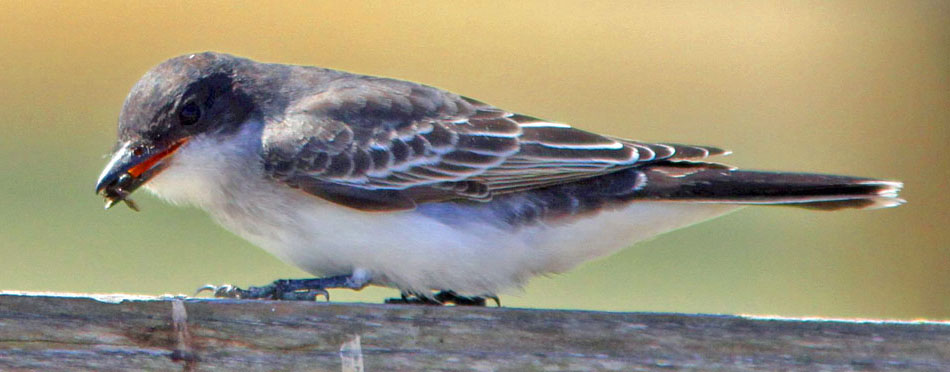 |
|||||||||
TYRANT FLYCATCHERS Tyrannidae |
|||||||||
|
|||||||||
The majority of tyrant flycatchers eat insects or arthropods, and many of them sit on perches from which they sally forth to catch insects in flight — they fly-catch. Our headliner, an Eastern Kingbird (above), has just caught a fly . . . or wasp or bee. The related Loggerhead Kingbird of the Caribbean (left) shows off its formidable bill used to catch and dispatch such flying insects. Eastern Kingbird (above) was the first tyrant flycatcher to be formally named. Linnaeus called it "Lanius tyrannus" in 1758, mistaking it for a shrike. Now known as Tyrannus tyrannus, it breeds widely in the United States and Canada, but the entire population migrates to South America in the winter. Most North American tyrannids are similarly migratory, heading to the Neotropics in winter.
|
|||||||||
The taxonomy of the Tyrannidae has changed over the years. First, work by Prum & Lanyon (1989), Chesser (2004), and Ericson et al. (2006) moved the tityras, becards, and allies [genera Tityra, Pachyramphus, Laniocera and Xenopsaris] to their own family, the Tityridae. More recently Tello et al. (2009) and Ohlson et al. (2013) proposed dividing the Tyrannidae into families: Onychorhynchidae (for Onychorhynchus, Myiobius, and Terenotriccus), Platyrinchidae (for Calyptura, Neopipo, and Platyrinchus), Tachurididae (for Tachuris), Rhynchocyclidae (for Mionectes through Oncostoma, with three subfamilies), and Tyrannidae (with remaining genera, divided into five subfamilies and several additional tribes). This was followed by Dickinson & Christidis (2014) but not by other major authorities and world checklists. Instead, Winkler et al. (2015) listed many of these as subfamilies and tribes, but put Onychorynchinae with family Tityridae. I generally follow the Winkler et al. subfamilies, but include the Onychorynchinae with the Tyrannidae, as does the South American Checklist Committee (SACC). I expect there will continue to be some tinkering in the future:
|
|||||||||
|
|||||||||
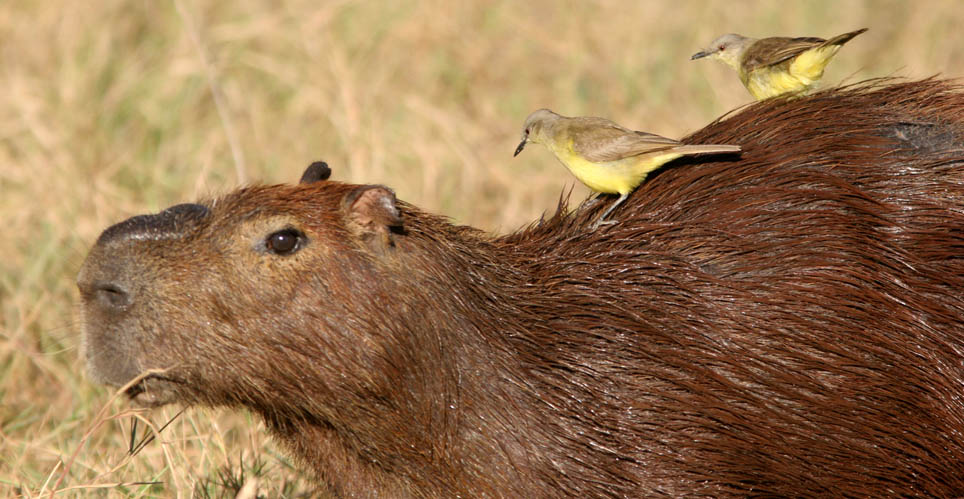 |
|||||||||
There is one tyrannid that doesn't behave like a flycatcher at all. The Ringed Antpipit Corythopis torquatus of the Amazon and Orinoco basins "walks with steady gait, one foot ahead of other, along dark forest floor, peering mainly upwards, occasionally springing up to strike at prey on leaf undersides overhead, with loud bill-snap at each attempt;" Fitzpatrick (2004). We watched one in the Chapadas dos Guimairés of southwestern Brazil as it bobbed its way along the forest floor like a waterthrush or forest pipit — the convergent evolution behavior was astonishing. And its up-scale, down-scale vocals were comical and distinctive: "do-WE-do, Rrrrrabbbitt?" Vocalizations are indeed important in sorting through the Tyrannidae. In some groups they are by far the best field identification characters. |
|||||||||
|
|||||||||
| Of course, some flycatchers are exceedingly colorful, including the widespread Vermilion Flycatcher (all 3 photos below) which ranges from the sw. United States through Central America to southern South America (including the Galapagos Islands), and may be composed of several species. The individual below left was an first-year male when it appeared at Moonglow Dairy, Monterey County, in Oct 2004, but then returned the following winter (below right, top) as a full adult male. Few vagrants are as eye-catching as this. Yet, incredibly, there in a population of Vermilion Flycatcher around Lima, Peru, in which the adult male is not red — but is, instead, blackish-brown (below right, bottom). Females in that population look like normally drab female Vermilions. | |||||||||
|
|||||||||
| Beyond color, some spectacular flycatchers have a colorful but oft-concealed crest: in the three species of royal-flycatcher in genus Onychorynchus this creates, when fully extended, a colorful forward-facing fan. Other tyrannids bear exceedingly long tails, as exemplified by the breath-taking Scissor-tailed Flycatcher (below) of the south-central United States. | |||||||||
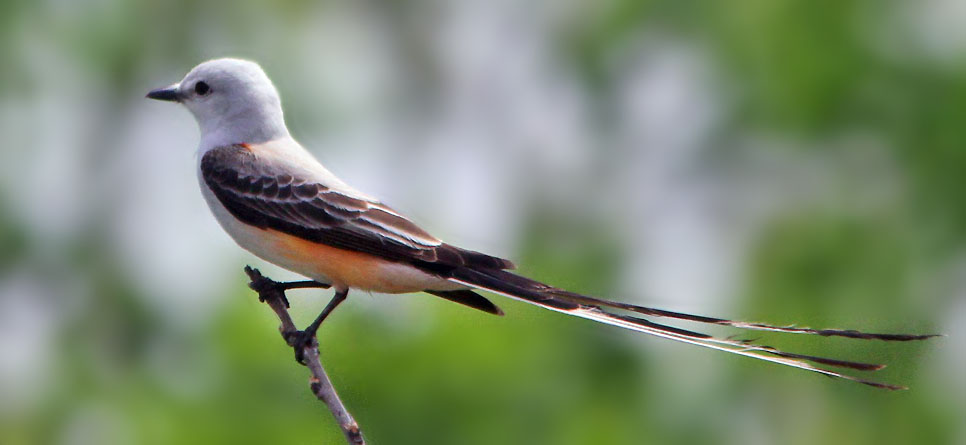 |
|||||||||
The Chapada Flycatcher was only described as a new species this century — split from the similar Suiriri Flycatcher Suiriri suiriri (Zimmer et al. 2001). The two species appear to be similar, but Chapada Flycatcher (below) has a unique dueting display between pairs during territorial encounters: males flip up their wings and fanned tail while females flicks her wings and fans her tail downward.
That was the first shocking discovery. The second occurred when DNA analysis was undertaken (Lopes et al. 2017). They discovered that not only are Suiriri and Chapada Flycatchers good species, but that they are not closely related all! They are not in even in the same genus. Suiriri Flycatcher is related to Phyllomyias and Phaeomyias flycatchers in subfamily Elaeniinae. Chapada Flycatcher is related to Sublegatus flycatchers in subfamily Fluviclinae. So despite the physical similarity of the two species, they evolved from very different branches on the Tyrannidae tree. Lopes et al (2018) suggested that "social mimicry is responsible for the remarkable convergence in size, shape, plumage coloration, and behavior in the adults" [juvenal-plumaged birds are different]. They placed Chapada Flycatcher in its own genus as Guyramemua affinis. |
|||||||||
Then there are those species about which little of their biology is known. In 2014 I witnessed an amazing display of Black-throated Tody-Tyrant, an otherwise small and unobtrusive in the lower and middle story of stunted, mossy cloud-forest high in the Andes. The sexes are similar, but what I took to be the male (below left) was seen to flutter in front of the female, giving excited calls, at Owlet Lodge, Amazonas, Peru. The behavior was witnessed several times and I even managed a photo (below right). Yet I could find no reference to this display in field guides or handbooks. Not until 2018, while putting together this page, did I discover that this courtship behavior had been described before, by Botero-Delgadillo & Krabbe (2011). They also determined that "loud, whirring sounds" that accompany these short hovering bouts are "likely produced by the male's rapid wing beats." |
|||||||||
|
|||||||||
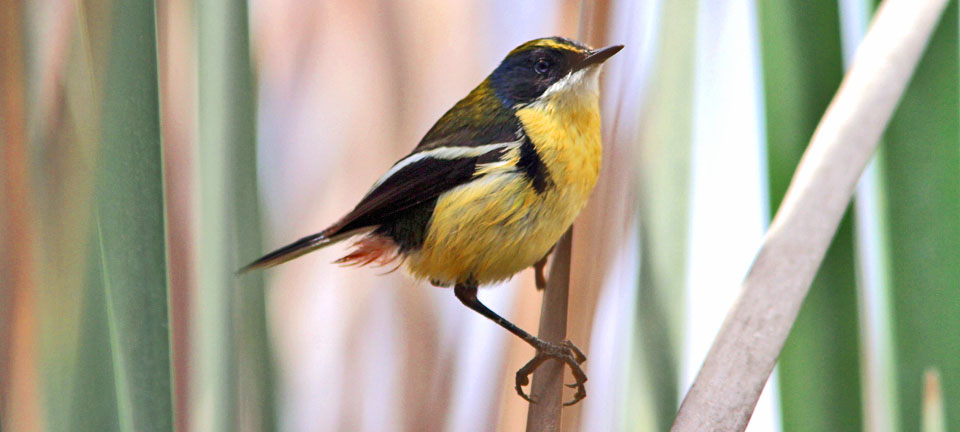 |
|||||||||
The Neotropics have various tyrannids, including the Rush-Tyrant and the Black-backed Water-Tyrant (right), there are restricted to marshy or water-edge habitats. Sharp-tailed Tyrant (below) is a tiny flycatcher of extensive campo and open grasslands, taller and wetter than disturbed grasslands, in southern South America. It is also so unique that it is placed in a monotypic genus (Culicivora). It has only ten rectrices, and these are long and graduated. It is rapidly becoming localized and scarce in isolated patches because of the loss of its habitat. |
|||||||||
 |
|||||||||
|
|||||||||
Not only is Wing-barred Piprites a local species, but Ohlson et al. (2013) found through molecular evidence that is was so distinctive from most tyrannid flycatchers that they proposed it should be in its own family, Pipritidae. It could be the oldest lineage among the Tyrannoidea. Speaking of local specialties, I rate the dapper White-cheeked Tody-Tyrant Poecilotriccus albifacies very high among tyrannid highlights. It is restricted to patches of bamboo in lowland rain forest of southeastern Peru and is certainly one of the prime species lodges along the Madre de Dios. We continue to learn more about flycatcher distribution. Even in my rather short excursions to the Andes, I found an Ochre-faced Tody-Flycatcher Todirostrum plumbeiceps in an unexpected range extension or vagrancy (Roberson 1996). The most mysterious of all the tyrannids is the tiny Kinglet Calyptura Calyptura cristata, known only from remnant lowland forests near Rio de Janeiro, Brazil. Specimens were obtained in the 19th century, but it went unrecorded for over a hundred years before its dramatic rediscovery in 1996. It vanished again just as mysteriously. Most of its preferred habitat has been cleared, and it remains the most elusive bird in the Neotropics. |
|||||||||
|
|||||||||
With 420 species in the Tyrannidae, there is no hope of providing much more than a short introduction here. There are a host of ground-dwelling flycatchers in South America using barren deserts or tree-less alpine meadows with names like "ground-tyrant" and "shrike-tyrant," or Spanish words like "monjita" or "negrito," that I've barely even mentioned. There was little chance to touch on breeding biology, but most tyrannids breed in monogamous pairs (but there are exceptions; Fitzpatrick (2004). Let's leave it with two shots of adult flycatchers feeding babies in my home location — Monterey County, California: Western Kingbird (below left) and Black Phoebe (below right). |
|||||||||
|
|||||||||
Photos: The Eastern Kingbird Tyrannus tyrannus was in lower Carmel Valley, California, USA, on 12 Sep 2013. The Loggerhead Kingbird Tyrannus caudifasciatus was at Hacienda Cortina, Cuba, on 5 Feb 2017. The collage of flight shots of a Tropical Kingbird Tyrannus melancholicus is from Laguna Grande Park, Seaside, California, on 1 Oct 2015. The Great Kiskadee Pitangus sulphuratus was at Intervales NP, Brazil, on 21 July 2010. The Short-tailed Pygmy-Tyrant Myiornis ecaudatus was near Bellavista, Peru, on 15 Nov 2014. The two Cattle Tyrant Machetornis rixosa riding a Capybara were in the Brazilian Pantanal, on 19 July 2010. The White-throated Spadebill Platyrinchus mystaceus was at Itatiaia NP, Brazil, on 4 Aug 2010. The Eye-ringed Flatbill Rhynchocyclus brevirostris was at Rio Tigre, Costa Rica, on 25 Dec 2007. The Planalto Tyrannulet Phyllomyias fasciatus was at Intervales NP, Brazil, on 30 July 2010. The Southern Beardless-Tyrannulet Camptostoma obsoletum was near Lima, Peru, on 24 Nov 2014. The White-crested Tyrannulet Serpophaga subcristata was at Itatiaia NP, Brazil, on 4 Aug 2010. The Sierran Elaenia Elaenia pallatangae at Huembo Reserve, Amazonas, Peru, on 24 Nov 2014. The Fuscous Flycatcher Cnemotriccus fuscatus was in the Brazilian Pantanal on 19 July 2010. The Western Wood-Pewee Contopus sordidulus was at Pt. Pinos, Pacific Grove, California, on 18 May 2016. The Pacific-slope Flycatcher Empidonax difficilis was at Pacific Grove, California, on 16 Sep 2014. The Willow Flycatcher Empidonax traillii was at Carmel River mouth, California, on June 2017. The first-fall male Vermilion Flycatcher Pyrocephalus rubinus was at Moss Landing, Monterey Co., California, on 10 Oct 2004; the returning adult male was at the same location on 13 Oct 2005. The dark morph male Vermilion was at Lima, Peru, on 26 Nov 2014. The Scissor-tailed Flycatcher Tyrannus forficatus was at Anahuac NWR, Texas, USA, on 25 Apr 2014. The Streamer-tailed Tyrant Gubernetes yetapa was in Emas NP, on 25 July 2010; the Chapada Flycatcher Guyramemua affinis was also in Emas NP the next day, and the male Cock-tailed Tyrant Alectrurus tricolor was there on 27 July 2010. The display in a pair of Black-throated Tody-Tyrant Hemitriccus granadensis was taken at Owlet Lodge, Amazonas, Peru, on 21 Nov 2014. The Many-colored Rush-Tyrant Tachuris rubrigastra was at the Villa marshes near Lima, Peru, on 26 Nov 2014. The Black-backed Water-Tyrant Fluvicola albiventer was in the Brazilian Pantanal on 19 July 2010. The Sharp-tailed Tyrant Culicivora caudacuta was Emas NP, Brazil, on 25 July 2010. The Bright-rumped Attila Attila caudifasciatus was at La Selva Reserve, Costa Rica, on 16 Dec 2007. The Sulphur-rumped Flycatcher Myiobius sulphureipygius was at Rio Tigre, Costa Rica, on 25 Dec 2007. The Johnson's [Lulu's] Tody-Flycatcher Poecilotriccus luluae was near Owlet Lodge, Amazonas, Peru, on 22 Nov 2014. The Common Tody-Flycatcher Todirostrum cinereum was in the Brazilian Pantanal on 22 July 2010. The Ornate Flycatcher Myiotriccus ornatus was at Afluenta, San Martîn, Peru, on 25 Nov 2014. The male Velvety Black-tyrant Knipolegus nigerrimus was at Itatiaia NP, Brazil, on 4 Aug 2010; the female Blue-billed Black-tyrant Knipolegus cyanirostris was photographed there on 6 Aug 2010. The Wing-barred Piprites Piprites chloris was at Intervales NP, Brazil, on 30 July 2010. The Cuban Pewee Contopus caribaeus was at Faro Paradon, Cuba, on 11 Feb 2017. The Eastern Wood-pewee Contopus virens was a vagrant at Laguna Grande, Seaside, California, on 5 Nov 2017. The Dusky-capped Flycatcher Myiarchus tuberculifer was a vagrant in Pacific Grove, Monterey Co., California, on 30 Dec 1992. The Western Kingbird Tyrannus verticalis was feeding young near San Ardo, Monterey Co., California, on 17 July 2001. The Black Phoebe Sayornis nigricans was feeding young at Pacific Grove, California, on 20 May 2017. All photos © Don Roberson; all rights reserved. Bibliographic note: There is no "family book" per se but the South American species are well covered in Ridgely & Tudor (1994) with a fine selection of species illustrated in color. An excellent introduction to this family, with some lovely photos, is Fitzpatrick (2004) in the Handbook of the Birds of the World series. Literature cited:
|
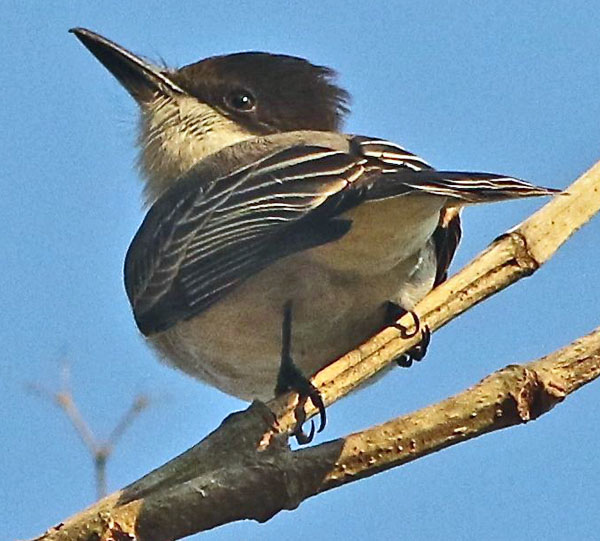 With
about 426 species in about 104 genera, the Tyrannidae is the largest
bird family on earth. There are other birds called "flycatchers" in the
Old World, divided into several families, but none of them are closely
related to the tyrant flycatchers. The tyrannids are entirely New World
birds, sometimes called "New World flycatchers."
With
about 426 species in about 104 genera, the Tyrannidae is the largest
bird family on earth. There are other birds called "flycatchers" in the
Old World, divided into several families, but none of them are closely
related to the tyrant flycatchers. The tyrannids are entirely New World
birds, sometimes called "New World flycatchers." 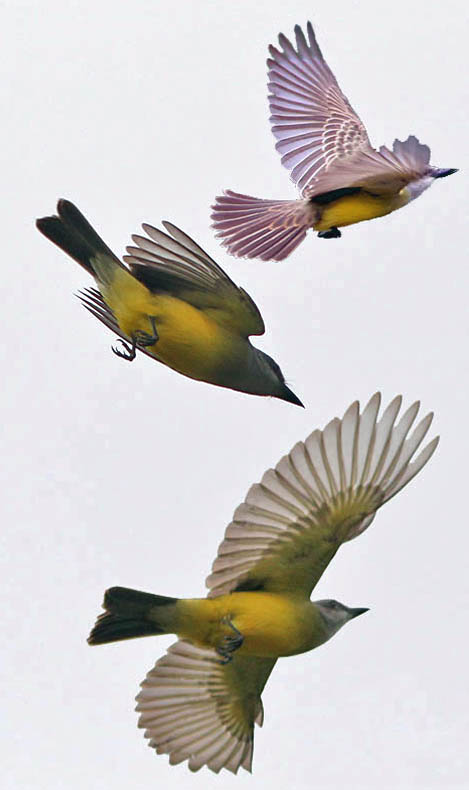 Here,
in the Neotropics, the migratory New World flycatchers mingle with
mostly resident tropical species of Central and South America. The most
widespread kingbird in the tropics is Tropical Kingbird
(right — a collage of flight shots of one vagrant in California in fall
migration). The center of tyrannid distribution is in South America.
While most North American species south to milder climates in the
northern winter, conversely, many flycatcher populations from southern
South America move north toward the equator in the austral winter.
Southern populations of Tropical Kingbird follow that pattern.
Here,
in the Neotropics, the migratory New World flycatchers mingle with
mostly resident tropical species of Central and South America. The most
widespread kingbird in the tropics is Tropical Kingbird
(right — a collage of flight shots of one vagrant in California in fall
migration). The center of tyrannid distribution is in South America.
While most North American species south to milder climates in the
northern winter, conversely, many flycatcher populations from southern
South America move north toward the equator in the austral winter.
Southern populations of Tropical Kingbird follow that pattern.  Tyrant Flycatchers are exceptionally variable is size, color, and behavior. Great Kiskadee
(left) is a very large flycatcher that ranges from the Rio Grande
Valley of south Texas all the way to Argentina. It impresses birders
with its size (up to 68 g), raucous calls, and its variation is
subspecies [this is the big-billed subspecies maximilliani of south and
eastern Brazil]. The largest tyrannid is the Great Shrike-Tyrant Agriornis lividus, a hook-billed predator of the high southern Ands with a weight up to 100 g. At that bulk it is 20 times the size of the tiny Short-tailed Pygmy-tyrant of the Amazon basin (below), which weighs in at 5 g.
Tyrant Flycatchers are exceptionally variable is size, color, and behavior. Great Kiskadee
(left) is a very large flycatcher that ranges from the Rio Grande
Valley of south Texas all the way to Argentina. It impresses birders
with its size (up to 68 g), raucous calls, and its variation is
subspecies [this is the big-billed subspecies maximilliani of south and
eastern Brazil]. The largest tyrannid is the Great Shrike-Tyrant Agriornis lividus, a hook-billed predator of the high southern Ands with a weight up to 100 g. At that bulk it is 20 times the size of the tiny Short-tailed Pygmy-tyrant of the Amazon basin (below), which weighs in at 5 g. 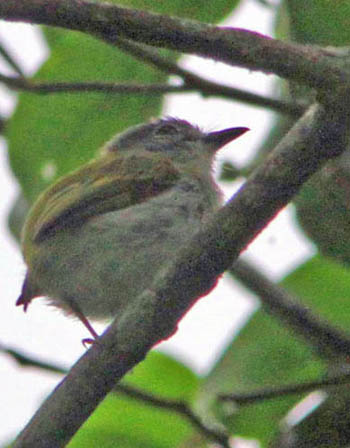
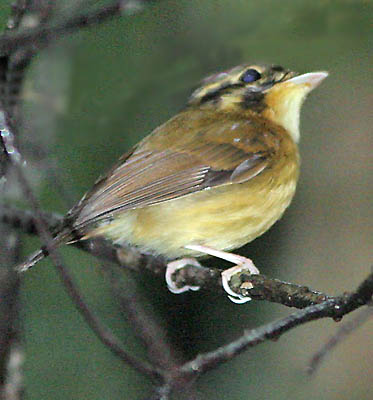 Tyrant Flycatchers thrive in a vast array of Neotropical habitats. A couple of Cattle Tyrant
(above) — a species of open savannas and agricultural areas — watch for
prey from the back a Capybara, the world's largest rodent, in Brazil.
In contrast, numerous flycatchers exist in the jungle understory,
including White-throated Spadebill of South America (near right) and Eye-ringed Flatbill of Central America (far right).
Tyrant Flycatchers thrive in a vast array of Neotropical habitats. A couple of Cattle Tyrant
(above) — a species of open savannas and agricultural areas — watch for
prey from the back a Capybara, the world's largest rodent, in Brazil.
In contrast, numerous flycatchers exist in the jungle understory,
including White-throated Spadebill of South America (near right) and Eye-ringed Flatbill of Central America (far right). 
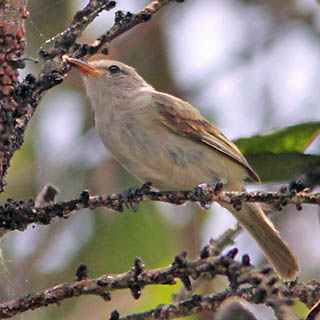


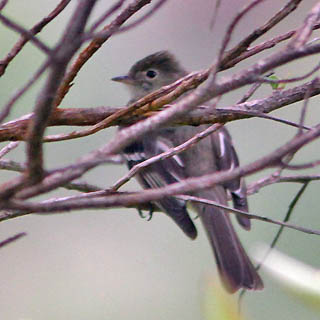
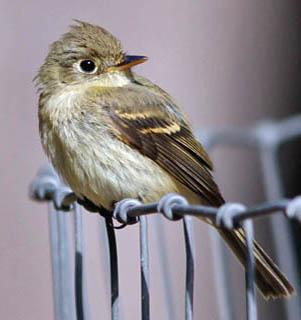
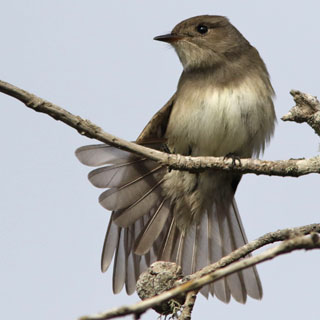
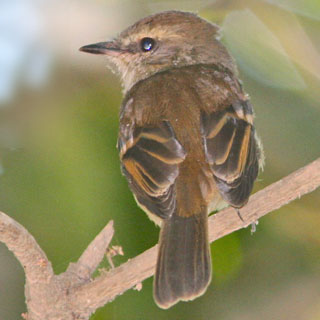
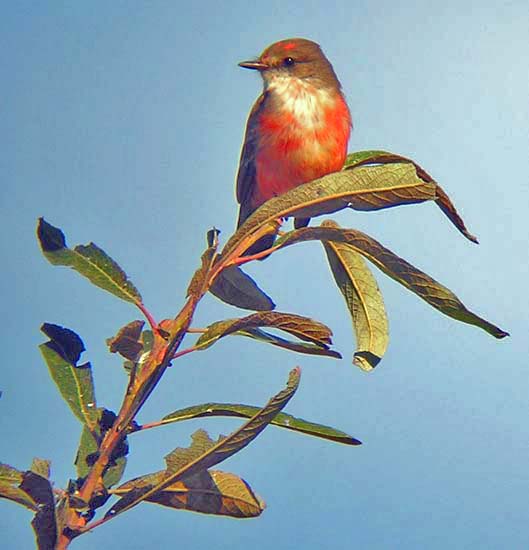
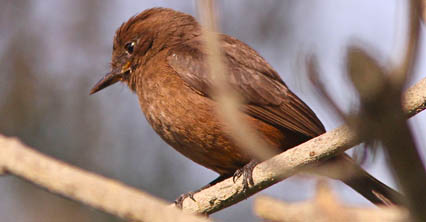
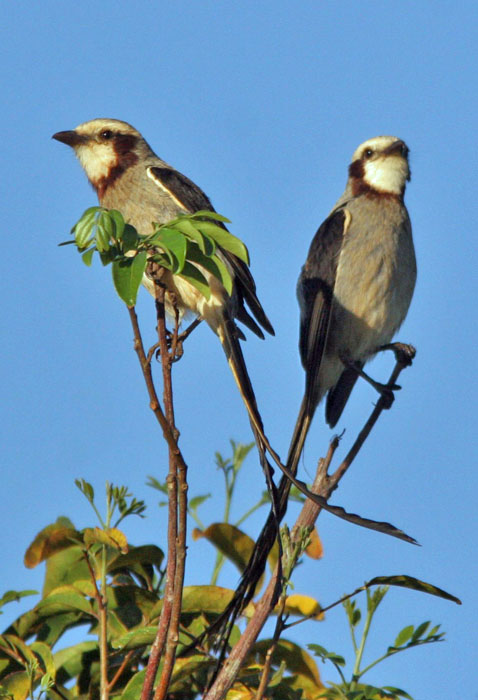 Amazing displays are featured by other species. The Steamer-tailed Tyrant of
damp grasslands in south-central South America lives in pairs or small
families. Breeding pairs have dueting displays in which they
alternatingly lower their heads while "raising their tails above the
horizontal, then raises head, lowers tail, and excitedly raises both
wings high overhead, while calling and bill-popping excitedly in
syncopation" (Fitzpatrick 2004). It is so unique that it is placed in
its own monotypic genus (Gubernetes).
Amazing displays are featured by other species. The Steamer-tailed Tyrant of
damp grasslands in south-central South America lives in pairs or small
families. Breeding pairs have dueting displays in which they
alternatingly lower their heads while "raising their tails above the
horizontal, then raises head, lowers tail, and excitedly raises both
wings high overhead, while calling and bill-popping excitedly in
syncopation" (Fitzpatrick 2004). It is so unique that it is placed in
its own monotypic genus (Gubernetes). 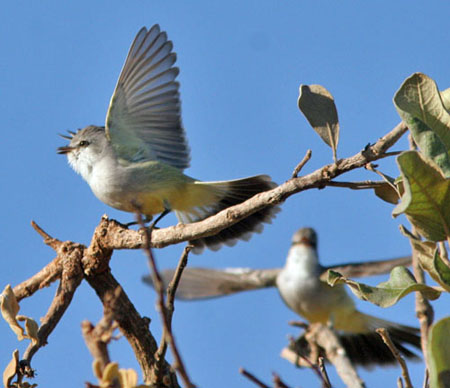
 Another species with interesting displays from south-central South America is Cock-tailed Tyrant (left). Its habitat is cerrado, campo,
and open grasslands. Males have an odd tail with stiff central
rectrices that are broad and twisted 90 degrees — in courtship flights
the male rises with fast fluttery wingbeats and alternates tail
position between straight down and cocked up well above horizontal
(Fitzpatrick 2004). It is increasingly becoming endangered and
localized as native grassland habitats are lost to agriculture.
Another species with interesting displays from south-central South America is Cock-tailed Tyrant (left). Its habitat is cerrado, campo,
and open grasslands. Males have an odd tail with stiff central
rectrices that are broad and twisted 90 degrees — in courtship flights
the male rises with fast fluttery wingbeats and alternates tail
position between straight down and cocked up well above horizontal
(Fitzpatrick 2004). It is increasingly becoming endangered and
localized as native grassland habitats are lost to agriculture. 
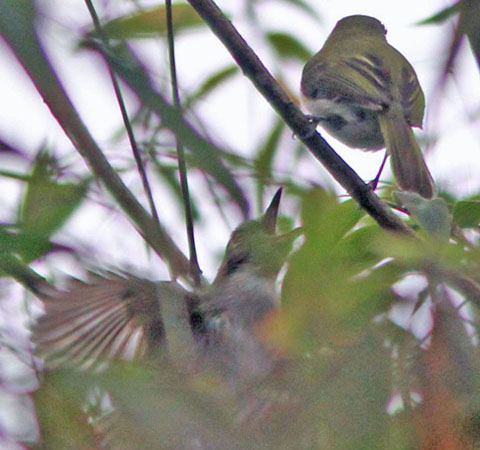
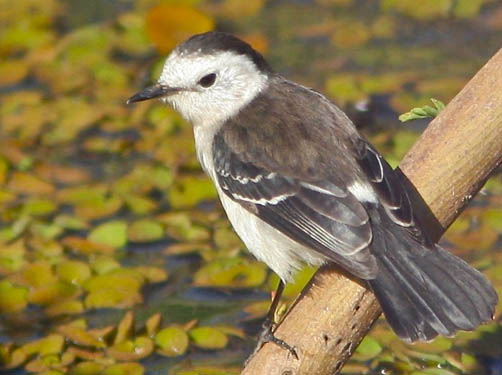 Both colorful and exotic is Many-colored Rush-Tyrant (above).
It is limited to reedy habitat in southern and coastal central South
America, and despite its gaudy plumage can be difficult to see as it is
a skulker. Recent molecular evidence suggests it and a few other
oddities (spadebills, piprites, Calyptura, and a couple of
others) are sister, evolutionarily, to all the hundreds of other
flycatchers in the Tyrannidae (Tello et al. 2009, Ohlson et al 2012,
2013). Some (e.g., Dickinson & Christidis 2014) would separate out
four subfamilies and elevate them to family status. Besides its
colorful plumage, I noticed the huge feet on the Rush-Tyrant.
Both colorful and exotic is Many-colored Rush-Tyrant (above).
It is limited to reedy habitat in southern and coastal central South
America, and despite its gaudy plumage can be difficult to see as it is
a skulker. Recent molecular evidence suggests it and a few other
oddities (spadebills, piprites, Calyptura, and a couple of
others) are sister, evolutionarily, to all the hundreds of other
flycatchers in the Tyrannidae (Tello et al. 2009, Ohlson et al 2012,
2013). Some (e.g., Dickinson & Christidis 2014) would separate out
four subfamilies and elevate them to family status. Besides its
colorful plumage, I noticed the huge feet on the Rush-Tyrant. 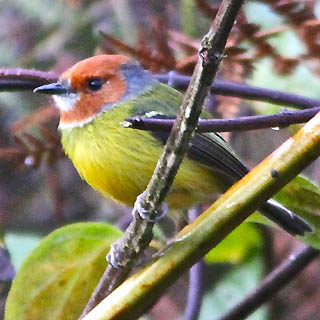
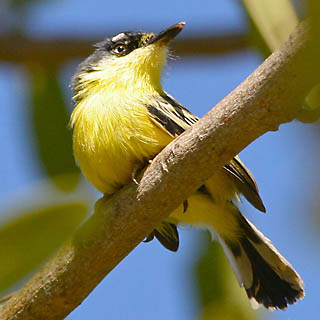
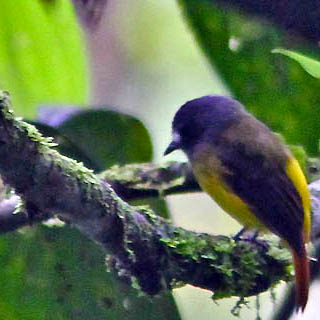

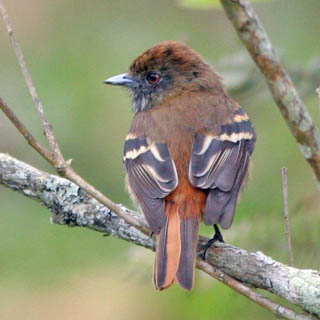
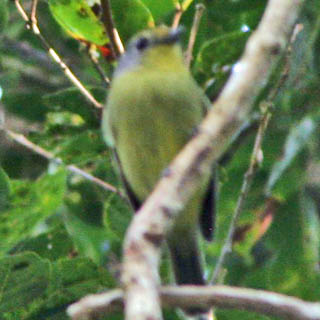
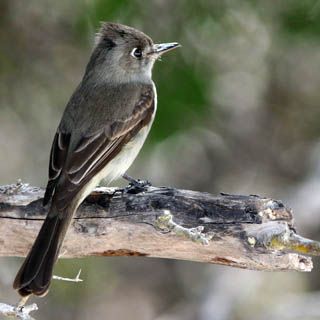
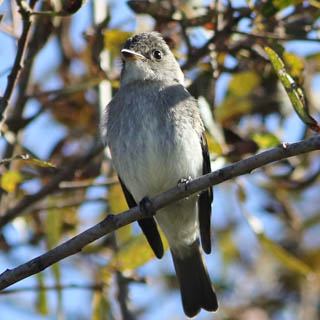
 Another group of tyrannids in which vocalizations are critical are the flycatchers in the genus Myiarchus.
Our current understanding of species limits in this reasonably large
group (22 species) comes from the work of ornithologists who considered
calls as well as more traditional museum methods (e.g., Lanyon 1967,
1978). Numerous good species had previously been masked by plumage
similarities until a study of vocalizations showed their
distinctiveness. But yet another cool things about the Myiarchus is that some species are migratory and therefore provide vagrants in the "wrong" direction. The Dusky-capped Flycatcher
(right) ranges from southeastern Arizona down through South America but
at least northern populations are migratory. Beginning about 45 years
ago, California birders have located one or two of these annually in
late fall or winter. The bird photographed at right was one of two
found in December 1992 in my own home town of Pacific Grove,
California, and I discovered one of them in my back yard! I'm fortunate
to have a variety of vagrants from my backyard but the wrong-way
Dusky-capped Flycatcher is surely among the best of the lot.
Another group of tyrannids in which vocalizations are critical are the flycatchers in the genus Myiarchus.
Our current understanding of species limits in this reasonably large
group (22 species) comes from the work of ornithologists who considered
calls as well as more traditional museum methods (e.g., Lanyon 1967,
1978). Numerous good species had previously been masked by plumage
similarities until a study of vocalizations showed their
distinctiveness. But yet another cool things about the Myiarchus is that some species are migratory and therefore provide vagrants in the "wrong" direction. The Dusky-capped Flycatcher
(right) ranges from southeastern Arizona down through South America but
at least northern populations are migratory. Beginning about 45 years
ago, California birders have located one or two of these annually in
late fall or winter. The bird photographed at right was one of two
found in December 1992 in my own home town of Pacific Grove,
California, and I discovered one of them in my back yard! I'm fortunate
to have a variety of vagrants from my backyard but the wrong-way
Dusky-capped Flycatcher is surely among the best of the lot.
